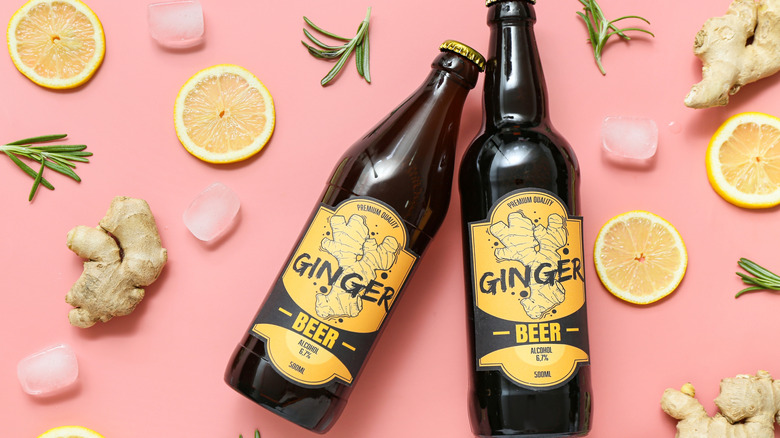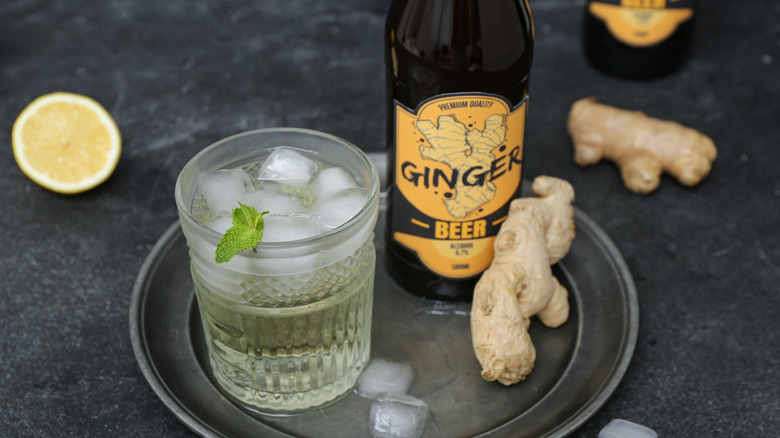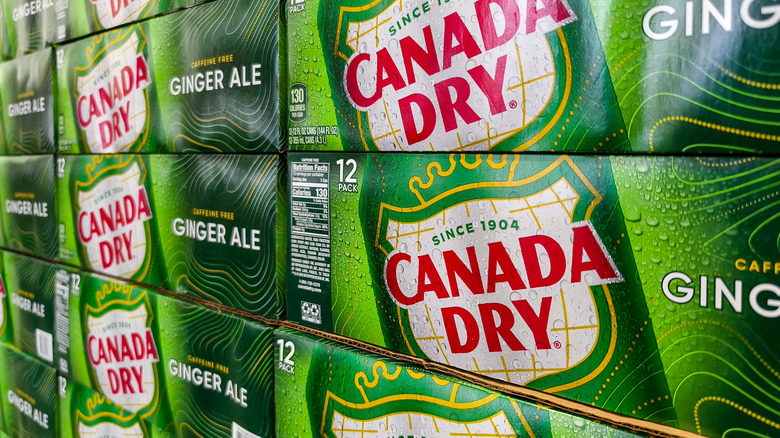Ginger Ale Vs Ginger Beer: What's The Difference?
A favorite of folks worldwide, ginger ale is widely known as the go-to drink when you're on a plane or have an upset stomach. Ginger beer, on the other hand, is a bit less well-known unless you're a fan of Moscow mules. While these two terms were once interchangeable, they diverged when pharmacist James Vernor in Detroit, Michigan, began releasing Vernor's Ginger Ale in 1866.
At a glance, the main differences between ginger ale and ginger beer come down to spice, sweetness, carbonation, and alcohol content. Ginger ale tends to have a sweeter taste, while ginger beer is often much spicier and is carbonated via fermentation instead of through artificial means.
That said, the variance can differ by brand. For instance, an artisanal ginger ale made from real ginger will have a bolder taste than some commercially produced ginger beers that use artificial flavors and lack fermentation. However, for this article, we will focus on the traditional definitions of these two beverages and how they differ.
What exactly is ginger beer?
When you hear the name ginger beer and see that it typically comes in bottles, it's easy to assume that it's an alcoholic beverage. Well, you'd be half right. While people have made drinks from ginger for thousands of years, ginger beer specifically arose in England in the 18th century. At that time, ginger beer was a fermented beverage made with ginger, sugar, and water. It was brewed with a ginger beer plant, a starter culture of bacteria and yeast similar to what's used in the production of kombucha. Due to fermentation, the drink became effervescent and had an alcohol content of up to 11%.
Modern ginger beer is made a bit differently than the traditional kind, and most are either non-alcoholic or contain only trace amounts. However, brands like Crabbies Ginger Beer and Royal Jamaican Ginger Beer do produce alcoholic varieties. Many mass-produced versions you'll find without alcohol today are carbonated with carbon dioxide instead of natural fermentation, which contributes to their low alcohol content.
That being said, not all non-alcoholic ginger beers are inauthentic. Bundaberg Ginger Beer, for instance, is brewed for three days using real ginger. It's then heated to remove any alcohol, leaving less than 0.2%. Real-deal ginger beer provides a dry, spicy sip and a punch of flavor that unfermented ginger beer and standard ginger ale simply can't match. Not only does it boast a strong flavor, but it's the perfect mixer for numerous cocktails!
What exactly is ginger ale?
Ginger ale as we know it is a much more recent creation than ginger beer, but it's still the oldest soda in America. One of the first iterations was Vernor'ss Ginger Ale, which you can still purchase today. This beverage became one of the most popular ginger drinks at the beginning of the 20th century. Not long after, in 1907, pharmacist John McLaughlin began selling his Canada Dry Ginger Ale as a successor to his McLaughlin Belfast Style Ginger Ale, which he created in 1890. Paler and less sweet than Vernor's, Canada Dry's popularity surged during prohibition, and it's still going strong today.
Unlike ginger beer, ginger ale is entirely non-alcoholic. It is typically much sweeter and far less spicy than its fermented cousin. In terms of overall flavor, ginger ale is milder and usually has a less pronounced ginger flavor, though this can vary by brand.
While early versions were flavored with ginger, most manufacturers today use artificial flavors or ginger extract, artificial dyes, and high-fructose corn syrup or sugar. Likewise, ginger ale is artificially carbonated rather than fermented, making it more bubbly than ginger beer. Although most commercially produced ginger ales no longer use real ginger root, some artisanal brands like Reed's and Blenheim make the beverage with natural ingredients and fresh ginger, resulting in a deeper flavor and more spice reminiscent of ginger beer.


